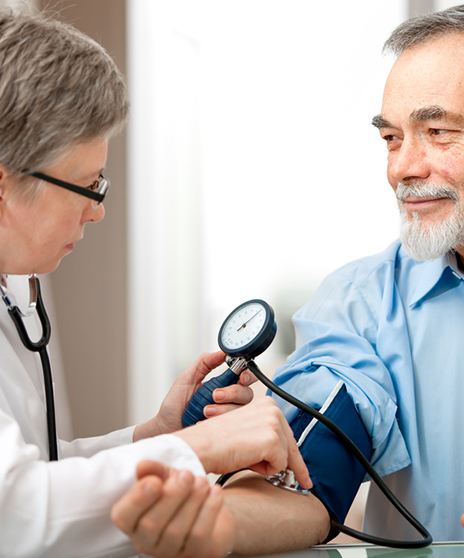Blood pressure is a measure of how hard the blood pushes against the walls of your arteries. It’s normal for blood pressure to go up and down throughout the day, but if it stays up, you have high blood pressure, also known as hypertension.
Two numbers tell you your blood pressure. The first number is the systolic pressure. It shows how hard the blood pushes when your heart is pumping. The second number is the diastolic pressure. It shows how hard the blood pushes between heartbeats when your heart is relaxed and filling with blood.
A blood pressure of less than 120/80 (say “120 over 80”) is ideal for an adult. High blood pressure is 140/90 or higher. You have high blood pressure if your top number is 140 or higher or your bottom number is 90 or higher, or both. Many people fall into the category in between, called prehypertension. People with prehypertension need to make lifestyle changes to bring their blood pressure down and help prevent or delay high blood pressure.
What happens when you have high blood pressure?
- Blood flows through your arteries with too much force. Over time, this damages the walls of your arteries. But you can’t feel it. High blood pressure usually doesn’t cause symptoms.
- Fat and calcium start to build up in your arteries. This buildup is called plaque. Plaque makes your arteries narrower and stiffer. Blood can’t flow through them as easily.
- This lack of good blood flow starts to damage some of the organs in your body. This can lead to problems such as coronary artery disease and heart attack, heart failure, stroke, kidney failure, and eye damage.
How can you prevent high blood pressure?
- Stay at a healthy weight.
- Try to limit how much sodium you eat to less than 2,300 milligrams (mg) a day. If you limit your sodium to 1,500 mg a day, you can lower your blood pressure even more.
- Buy foods that are labeled “unsalted,” “sodium-free,” or “low-sodium.” Foods labeled “reduced-sodium” and “light sodium” may still have too much sodium.
- Flavor your food with garlic, lemon juice, onion, vinegar, herbs, and spices instead of salt. Do not use soy sauce, steak sauce, onion salt, garlic salt, mustard, or ketchup on your food.
- Use less salt (or none) when recipes call for it. You can often use half the salt a recipe calls for without losing flavor.
- Be physically active. Get at least 30 minutes of exercise on most days of the week. Walking is a good choice. You also may want to do other activities, such as running, swimming, cycling, or playing tennis or team sports.
- Limit alcohol to two drinks a day for men and one drink a day for women.
- Eat plenty of fruits, vegetables and low-fat dairy products. Eat less saturated and total fats.
How is high blood pressure treated?
- Your doctor will suggest making lifestyle changes. For example, your doctor may ask you to eat healthy foods, quit smoking, lose extra weight, and be more active.
- If lifestyle changes don’t help enough or your blood pressure is very high, you will have to take medicine every day.
Follow-up care is a key part of your treatment and safety. Be sure to make and go to all appointments and call your doctor if you are having problems. It’s also a good idea to know your test results and keep a list of the medicines you take.
Care instructions adapted under license by Preview. This care instruction is for use with your licensed healthcare professional. If you have questions about a medical condition or this instruction, always ask your healthcare professional. Healthwise, Incorporated disclaims any warranty or liability for your use of this information.


